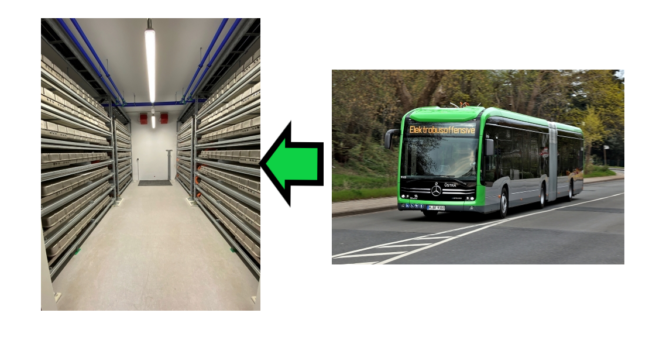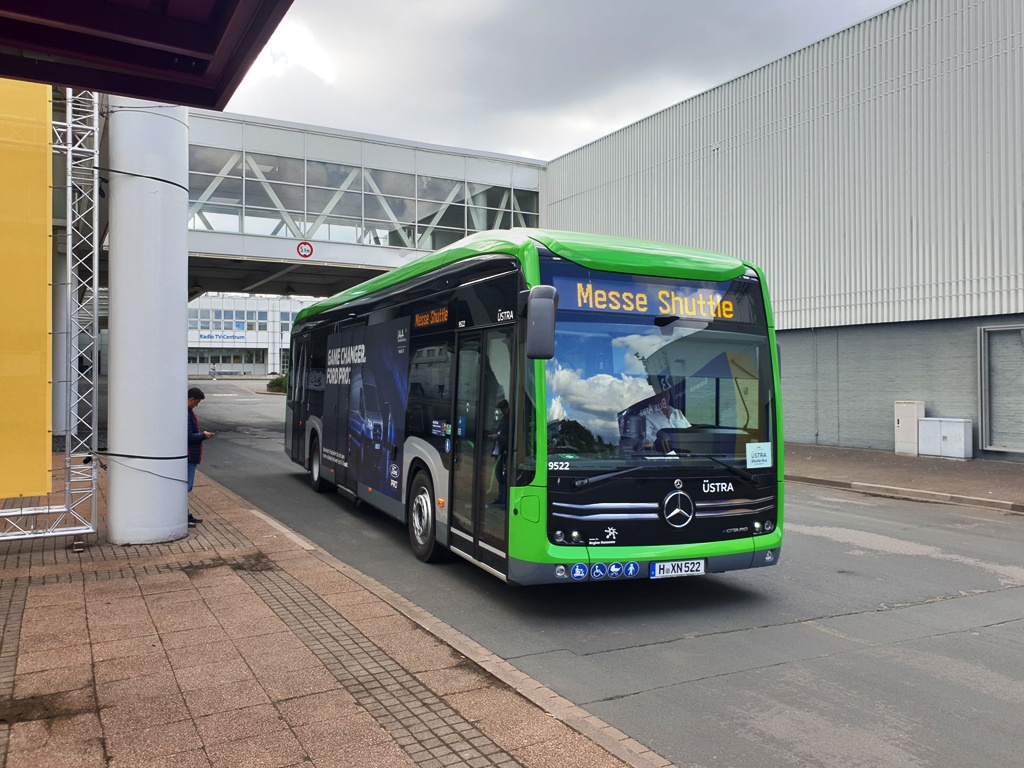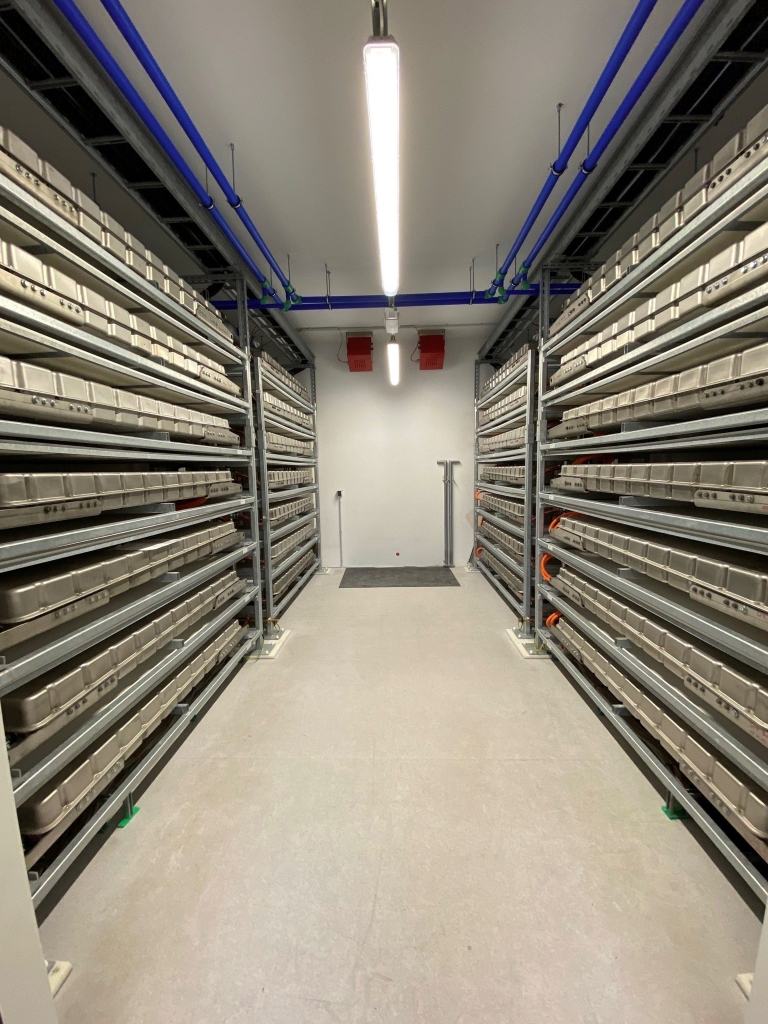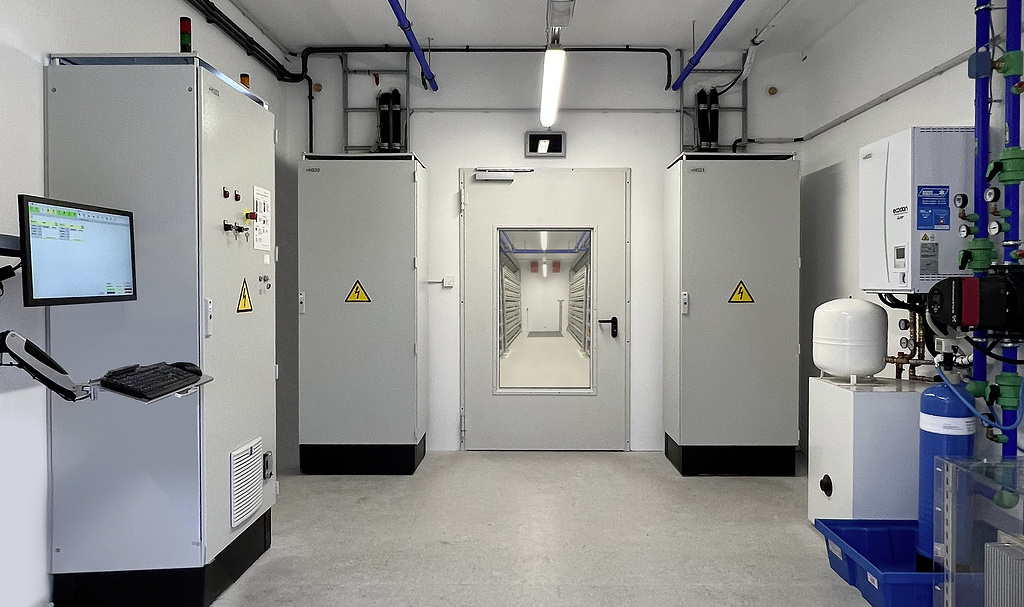
The life cycle of a drive battery does not necessarily end after having been used in a vehicle. The GUW+ pilot project at Üstra Hannoversche Verkehrsbetriebe AG, to which Daimler Buses is a partner, demonstrates this. In this project, which was announced in 2021, battery systems from Mercedes-Benz eCitaro city buses are given a second life as stationary energy storage units. This innovative energy storage solution was developed and implemented by Mercedes-Benz Energy GmbH. The storage system at Üstra’s rectifier substation, which has now been put into operation in Hanover, provides a shared, simultaneous energy supply for the public transport operator’s eCitaro electric buses and light rail.
The stationary storage solution of this pilot project is not only regenerative and configurable, it can also be adapted as necessary for other applications and scaled accordingly. Further added value: Finding a second life for these batteries as stationary energy storage units reduces the life-cycle costs of the eCitaro. At the same time, using Üstra’s existing infrastructure, consisting of buildings, grid connection, and power electronics, has a positive effect on investment costs and allows for additional amortization options.
The stationary energy storage unit has a total capacity of more than 500 kWh. It consists of 28 second-life battery systems from the Mercedes-Benz eCitaro. Every eCitaro city bus is equipped with powerful NMC battery packs, which are now, for the first time, being given a second life in a stationary energy storage unit as part of the GUW+ pilot project in Hanover, once their vehicle-specific range limit has been reached.

Stationary battery storage secures second life for electric bus batteries
Staying true to its understanding of sustainability, Daimler Buses is taking a holistic approach to the life cycle of buses and their battery systems. Once an electric NMC drive battery in the all-electric, locally emission-free, and silent Mercedes-Benz eCitaro city bus has dropped to around 80 percent of its original capacity after some five to six years of operation, replacement is usually necessary in order to ensure the range required of these city buses.
However, in stationary operation, where capacity losses play only a minor role, these batteries are still fully capable of being operated for up to ten years. The continued use of these batteries as stationary energy storage modules in a second-life application means that these batteries can provide additional economic benefit and help the eCitaro maintain a environmental balance.
The batteries in Üstra’s stationary battery storage pilot project currently still come from eCitaro city buses used by Daimler Buses to conduct test drives of thousands of kilometers. In the future, the stationary energy storage unit can be expanded with batteries swapped out from the 49 all-electric eCitaro rigid and articulated buses currently run by Üstra.
Flow of local power storage and supply in Hanover
The rectifier substation in Hanover powers Üstra’s light rail and electric buses and is connected to the public power grid. The energy storage unit serves as a buffer, allowing recuperated energy to be used efficiently for light rail. By storing energy in this way, it is possible to balance load peaks and ensure smooth, continued operation in the event of a grid failure.
Üstra also focuses on powering public charging infrastructure and feeding excess capacity into the public power grid. At times when too much electricity is produced and there is higher demand on the public grid, these peaks must be covered without overburdening the electricity grid and while keeping blackout scenarios in the energy supply manageable. Üstra has set up a specially designed charging station on its premises in order to charge its electric buses using the rectifier substation’s storage system.
The pilot project, which is the first to integrate used electric bus batteries from pre-series eCitaro vehicles, has been in the implementation phase since 2021. This phase is now complete with the full integration of this battery storage system that ensures smooth, safe, and regular long-term operation. In addition to intensive test runs, the trial and identification phase involved the integration of this storage system into Üstra’s entire technical environment, including the electrical control systems for its light rail power grid, as well as the finalization of the fire safety concept.

From battery storage pilot project to scalable series solution
The concept of the GUW+ stationary battery storage pilot project is primarily intended for validation with respect to potentially using batteries from Üstra’s regular eCitaro bus fleet once they have reached their capacity limit. Üstra’s 49 eCitaro electric city buses have been put into operation gradually since 2020, with 490 batteries expected to be integrated into the second-life storage solution starting in 2026. This would enable Üstra to completely cover its energy needs with its own batteries in stationary second-life operation, thus boosting its profitability.
The project to extend the useful life of electric bus batteries is generally scalable in size and scope. This makes it suitable as a basis for further development of this concept and its future implementation as an economically-efficient series-production solution that gives eCitaro vehicle batteries a second life.
Potential of stationary energy storage systems for public transport operators
Üstra, and other public transport operators, can upgrade the stationary energy storage unit as necessary and adapt it to their requirements. For example, there are already plans for a container solution that does not use existing space on site. Instead, it can be flexibly integrated according to different local conditions.
Another option would be to integrate the power supply into the charging infrastructure for additional electric vehicles, such as municipal vehicles or employee cars. In addition, energy can be stored for use in on-site workshops or administrative departments, leading to a considerable increase in the economic benefit from the operator’s investment in a second life for its batteries by replacing swapping them out and using them as stationary units.
Another interesting solution would be to combine this storage system with photovoltaic systems installed on roofs, production plants, and on-site parking facilities. The intermediate storage of solar power in second-life battery systems from the eCitaro, and the local use of power generated on site, e.g., for overnight vehicle charging, meets the needs of numerous public transport operators and service companies aiming to increase the profitability of their electric bus fleets as part of their total cost calculation.
Last but not least, the GUW+ pilot project for Daimler Buses also serves to evaluate the option of using the stationary energy storage unit as a spare storage unit: New batteries for the eCitaro, stocked by Daimler Buses or service operators, and intended for use as replacement units in the event of a sudden vehicle battery failure, can be integrated into stationary storage systems for operation at low load until they are used in an electric bus. In this way, batteries can be kept in good condition until they are used on an electric bus, effectively preventing them from aging prematurely.
Development and implementation of the energy storage unit – the GUW+ project
The GUW+ project is funded by Germany’s Federal Ministry for Digital Affairs and Transport (BMDV) as part of the Electromobility Funding Directive. In addition to consortium leader Alstom Transport Deutschland GmbH, based in Salzgitter, Germany, the consortium also includes Elpro GmbH from Berlin, Motion Control and Power Electronics GmbH, Fraunhofer IVI in Dresden, and the Dresden University of Technology. Daimler Buses supports the project as an associated partner.
As a subsidiary of Mercedes-Benz AG, Mercedes-Benz Energy GmbH specializes in “second life” and “spare storage units” applications, and is responsible for the development and implementation of the energy storage unit for the GUW+ project on behalf of Fraunhofer IVI.
Daimler Buses provided the batteries and assisted in the development of the software and control components. Recently established, Daimler Buses Solutions GmbH will implement future second-life applications based on batteries from the Mercedes-Benz eCitaro as part of turnkey solutions for the electric bus infrastructure of public transport operators.
(Info: Daimler Truck AG)


